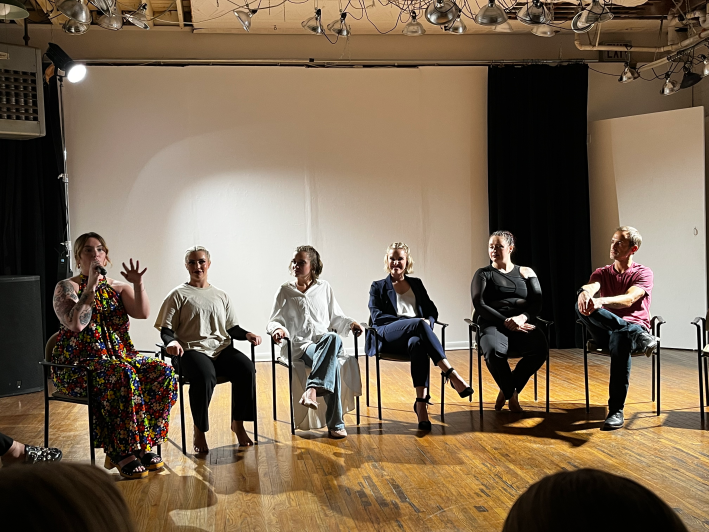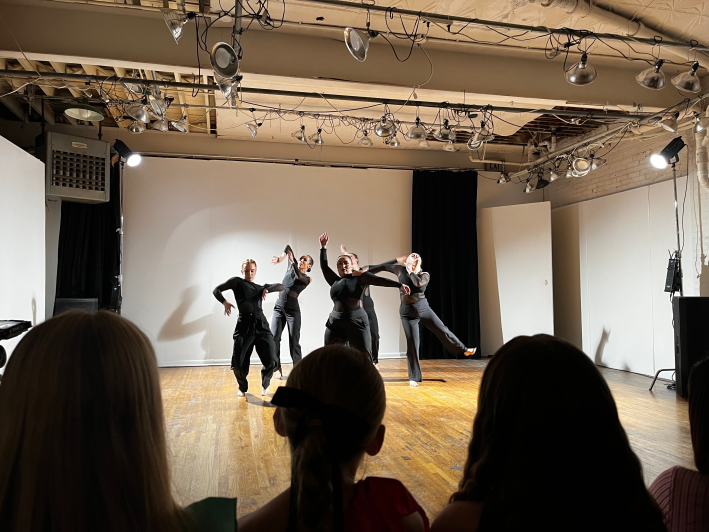Presenting The Tulsa Contemporary Collective
Liggett Studio
September 6, 2025
The arts in Tulsa are popping off at every level, from legacy companies and international-collector-attracting exhibits to DIY theatre shows and performance art presented in a U-Haul truck. One area that’s been lagging a bit is contemporary dance, which has always occupied a tiny pie-slice of the creative offerings in Tulsa, partly due to the general “huh?” with which the art form tends to be greeted around here, and partly due to the costs involved in putting it together—like finding studio and performance space with a body-friendly floor, dancer training, and the amount of rehearsal time it takes to develop this kind of work.
Every now and then there’s a little boom in independent contemporary dance here, though, and we seem to be in one now. In the past year, after a quiet spell, several new homegrown groups have popped up: Kin Dance Company, Motus Dance Collective, Transitive State (which, full disclosure, I’m in), and Tulsa Contemporary Collective are now in the mix with Oklahoma Movement—still going strong after the last boom more than a decade ago—in bringing contemporary movement experiences to the city.
The members of Tulsa Contemporary Collective, which gave its debut performance earlier this month at Liggett Studio, bring their own unique experience to the mix. Many of them grew up in—and now teach at—local studios on the competition circuit, training young dancers in a variety of styles and creating choreography that those students take to regional and national championships. Some of these women make dozens of dances a year for these young people, but they rarely get to perform themselves, or to make work that’s not tailored for kids and competitions—in other words, to be artists as well as teachers.
This group, led by Shana Barriga, gives these grown-up dancers a space to create for themselves. Their first show was a strong beginning, featuring five short pieces, three dance films, and a post-show discussion with the choreographers, who are also dancers in the collective. Their approach is refreshingly collaborative: several members created works together, and filmmaker and photographer Logan Miller worked closely with the group on portraits displayed in the gallery and on the films interspersed through the live performances, using his camera with 360-degree range and fluid movement, almost like another dancer in the space.

The Collective’s 11 dancers are extremely strong, able to move smoothly between athletic technical feats—giant leg extensions, whip-fast jumps—and poignant, sensitive moments, so that the “tricks” integrated well within the other elements in a given piece. I loved the attention to detail in their feet and the energy they sent all the way through their fingertips: no wasted moments. Dancer Mackie J was a consistent standout, ranging effortlessly among styles, and moving with a quiet power that didn’t push me but rather drew me into her world.

Formations and transitions are strengths for the Collective's choreographers, who kept the eye flowing from one clear visual idea to the next. (The arrangement of the seats—lined up in rows in front of an open space—sometimes made it hard to see what was going on, especially when the dancers were moving on the floor.) “Creeks” by Mackie J and Christianna Thrutchley and “Breather” by Alexis Chasteen demonstrated particularly fresh choreographic ideas. The former was a gripping duet full of grounded movement, unexpected contact points, and off-balance direction shifts, making space for deep feeling to well up. The latter sent five dancers on a taut, propulsive journey through suspension and release within the waveforms of club music; my attention didn’t waver for a second, and I wanted to see it again immediately.

The show covered some tender personal ground, from religious trauma to addiction to body dysmorphia, and Collective member Sydney Jennings movingly shared about the themes of each piece before it was performed. I usually prefer to find my own meaning or narrative in the movement itself, but I appreciate how descriptive language like this offers an audience genuinely helpful points of access and connection to an art form that can seem obscure.
There are many moments from this show that I won’t forget, but one in particular really stays with me. In a dance film called “Whispers,” choreographed by Jennings, the full company moved on a leaf-strewn field in front of a copse of bare-branched trees. One by one the dancers reached up an arm, so that for a moment they became part of the forest: a movement that communicated unity, persistence, and a clear declaration of presence, without a single word spoken.
Tulsa Contemporary Collective has made a decisive entry onto the local dance scene, and their work has intention, heart, and vision. I love that these artists have committed to making a place for themselves, one where they can grow and explore and show their young students (some of whom were in the audience for this performance) that there’s more to a life in dance than competition.






